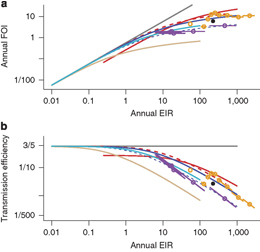Research Abstract
マラリアの伝播効率と流行強度の関係の定量的解析
本論文では、マラリアの流行強度と伝播効率の間の著しく非線形的な関係を明らかにしており、こうした関係は不均一な刺咬を考えるモデルによってはうまく記述されないことを示す。
A quantitative analysis of transmission efficiency versus intensity for malaria
2010年11月2日 Nature Communications 1 : 108 doi: 10.1038/ncomms1107

マラリアの流行の強さと伝播効率の間の関係は、マラリアの疫学的研究、伝播あるいは発生率を評価点とする無作為化対照試験の設計、およびマラリアの伝播と その防御の評価およびモデル化に重要である。マラリア伝播効率を定量化してその流行強度との関係を記述し、効率の悪い伝播の原因を解明し、蚊が媒介する病 気の伝播のモデル化に適している関数を同定する目的で、20世紀に発表された5種類に分類される研究を組み合わせて解析し直した。本論文では、このような 解析がマラリアの流行強度と伝播効率の間の著しく非線形的な関係を明らかにしており、こうした関係は不均一な刺咬を考えるモデルによってはうまく記述され ないことを示す。感染につながる刺咬の多くが少数の人々に集中している場合、感染およびマラリア原虫個体群の構造は高度に集中したものとなり、マラリアの 免疫疫学的性質、マラリア原虫の生活史形質の進化生態学や、対照についての昆虫学的および疫学的データを使った伝播の計測と層化に影響を及ぼすと考えられ る。
- フロリダ大学(米)
The relationship between malaria transmission intensity and efficiency is important for malaria epidemiology, for the design of randomized control trials that measure transmission or incidence as end points, and for measuring and modelling malaria transmission and control. Five kinds of studies published over the past century were assembled and reanalysed to quantify malaria transmission efficiency and describe its relation to transmission intensity, to understand the causes of inefficient transmission and to identify functions suitable for modelling mosquito-borne disease transmission. In this study, we show that these studies trace a strongly nonlinear relationship between malaria transmission intensity and efficiency that is parsimoniously described by a model of heterogeneous biting. When many infectious bites are concentrated on a few people, infections and parasite population structure will be highly aggregated affecting the immunoepidemiology of malaria, the evolutionary ecology of parasite life history traits and the measurement and stratification of transmission for control using entomological and epidemiological data.

